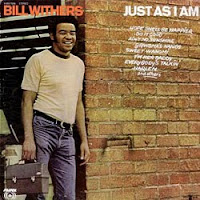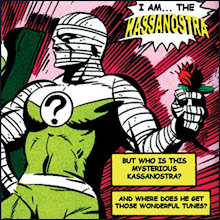Was thinking about suspending the Beatles finale for a Mary Travers post, but I'm not enough of a PP&M fan to throw something ad hoc together that's also properly respectful. Something we'll get to later, maybe. Right now, let me tell you how it will be. . .
 If you were born anytime after 1968, chances are that Bob Dorough was one of your favorite performers before you were ten years old, without your ever knowing his name. That's because Dorough (pronounced like The Explorer) was the artistic director behind ABC's Schoolhouse Rock! cartoon shorts that've been running on Saturday morning TV since the early 70s – think Three Is a Magic Number, among other classics. When not edu-taining millions of children, Dorough is better known as one of the most eclectic jazz singers of the last fifty years, having released close to two dozen albums, and holding the distinction of being the only vocalist to ever record with Miles Davis (on Davis' 1962 Sorcerer LP). Among his many accomplishments is a quickie collaboration with jazz bassist Steve Swallow: The 44th Street Portable Flower Factory was one of two EPs recorded as promotional giveaways for Scholastic Books. It's unbelievable where great music turns up sometimes. There very well may be better versions of Blackbird floating around, but there is only one Bob Dorough, and getting him into this blog gives me a warm and fuzzy feeling. Also, there aren't any better versions of Blackbird floating around, 'cause Dorough's that amazing.
If you were born anytime after 1968, chances are that Bob Dorough was one of your favorite performers before you were ten years old, without your ever knowing his name. That's because Dorough (pronounced like The Explorer) was the artistic director behind ABC's Schoolhouse Rock! cartoon shorts that've been running on Saturday morning TV since the early 70s – think Three Is a Magic Number, among other classics. When not edu-taining millions of children, Dorough is better known as one of the most eclectic jazz singers of the last fifty years, having released close to two dozen albums, and holding the distinction of being the only vocalist to ever record with Miles Davis (on Davis' 1962 Sorcerer LP). Among his many accomplishments is a quickie collaboration with jazz bassist Steve Swallow: The 44th Street Portable Flower Factory was one of two EPs recorded as promotional giveaways for Scholastic Books. It's unbelievable where great music turns up sometimes. There very well may be better versions of Blackbird floating around, but there is only one Bob Dorough, and getting him into this blog gives me a warm and fuzzy feeling. Also, there aren't any better versions of Blackbird floating around, 'cause Dorough's that amazing.  Gabor Szabo is Hungary's all-time greatest jazz guitarist, bar none. (Which lends a little something extra to the "he's world famous in Poland" gag.)
Gabor Szabo is Hungary's all-time greatest jazz guitarist, bar none. (Which lends a little something extra to the "he's world famous in Poland" gag.)It'd be great if the global universality of Beatle-powered love and good will is what led him to a seemingly unlikely collaboration with Lena Horne, but in actuality, Szabo played on-and-off in her backup band for a few years, and they ended up cutting an album together in 1969; Rocky Raccoon was the b-side of the album's only hit, Watch What Happens. Look, this is just a flat-out brilliant cover – way bluesier and seedier than the original. Which may be for the best, given that the subject material covered here includes infidelity, fisticuffs, hard living, frontier-style vengeance, the cheap moralizing of a remorseless god, and quite possibly a large anthropomorphized nocturnal varmint cavorting undetected amongst humans. (Sorry – after years of completely misunderstanding the song, I can't not think of the protagonist that way. My version is just as poignant, dammit!)
Lena Horne & Gabor Szabo: Rocky Raccoon
 How the hell did Come Together ever become a song to rock out to? A few power chords in the chorus notwithstanding, it's one of the Beatles' smoothest numbers. (There's no way that's really the Paul/Ringo rhythm section driving this tune. Don't care what George Martin says. I'm gonna need to see the birth certificate.) I'd really like to blame this on Aerosmith, whose crappy 1978 version turned it into a hard rock anthem. But that doesn't explain swagger-happy pre-'78 versions by Gladys Knight & The Pips, Ike & Tina Turner, and. . . Count Basie?!? (Yeah. . . the less said about that last one, the better.) So I really appreciate The Brothers Johnson for going against the grain on this one with a cover that taps into the original's inherent grooviness. The dual lead vocal effect is an especially nice touch.
How the hell did Come Together ever become a song to rock out to? A few power chords in the chorus notwithstanding, it's one of the Beatles' smoothest numbers. (There's no way that's really the Paul/Ringo rhythm section driving this tune. Don't care what George Martin says. I'm gonna need to see the birth certificate.) I'd really like to blame this on Aerosmith, whose crappy 1978 version turned it into a hard rock anthem. But that doesn't explain swagger-happy pre-'78 versions by Gladys Knight & The Pips, Ike & Tina Turner, and. . . Count Basie?!? (Yeah. . . the less said about that last one, the better.) So I really appreciate The Brothers Johnson for going against the grain on this one with a cover that taps into the original's inherent grooviness. The dual lead vocal effect is an especially nice touch. The Brothers Johnson: Come Together

There's something about Annie Clark – better known onstage as St. Vincent – that scares the crap out of me. Seriously people, check out her video for Actor Out of Work. Every time she opens her mouth wide I think a murder of crows is gonna fly out and peck everyone bloody.
But. . . she's got a voice like frostbite, and her acute, gossamer vocals balance nicely with the porcelain-and-razor wire creepiness of her visual effect. I know she covered Dig a Pony for her Black Cab Session; here's a better audio take, from a 2007 show at the Modern Art Museum of Fort Worth. This song should be pushing all of your eerie-childlike-gibberish buttons anyway, even before you knew she did a take of it. Dig a pony, indeed! Don't the Children of the Corn sing this one in unison? (Not harmony, unison.) Well. . . they should.
St. Vincent: Dig a Pony [live]

If there's a more predictable way to wrap things up than with Let It Be, I can't think of it. Every recording artist in the history of the world may very well have covered this song at one time or another. Thing is, most of 'em play up the gospel angle of the song, which is a mistake. While the Beatles' version obviously draws cues from religious music, it really isn't anything more than an anthemic rock ballad with a little stained glass window dressing. Even John was put off by its generic quality, remarking that it could've just as easily been done by Wings. Artists who try to drag this song closer to its original roots quickly discover there's nowhere to go after those opening chords; they're thinking old-time gospel, but what they end up with is often overwrought, and sometimes even schmaltzy. With that in mind, I'm going with Bill Withers, who manages to pull off a rendition that's spiritual but also vibrant and uplifting. It turns out to be exactly the right way to handle the song, and it makes you wonder if he kept the arrangement in mind a year later when he wrote Lean on Me.
Bill Withers: Let It Be

BONUS NON-TOLLAND ALL-TIME KASSANOSTRA GREATEST BEATLES COVER EVER: Eleanor Rigby is a song we pretty much never sing in camp – we may be the only ones. Much like Let It Be, there are hundreds of recorded versions of this song. (A little Liverpudlian poverty and degradation are the perfect way to class up anyone's album, don'tcha know!) Unlike Let It Be, there are a lot of very good covers out there. Some of them – Aretha Franklin's come to mind – are transcendent. But! If the KassaNostra's learned one unimaginably vital thing in all his years scouring the world for musical sublimity, it's this: never underestimate the raw lounge jazz power of five Filipino-American sisters (plus backing combo) and guiding ex-Zappa collaborator to lay bare the innate depravity in a hit song about the death of a forlorn spinster, and to do it with unquestionable style. Ladies and gentlemen, I give you The Third Wave (from their 1969 Here and Now LP).
The Third Wave: Eleanor Rigby
And that's it! Next week: The Rolling Stones Kinderland tribute extravaganza!!! Hmmmm. . . may need six posts to cover that one.
Peace & Vinyl,
The KassaNostra


No comments:
Post a Comment